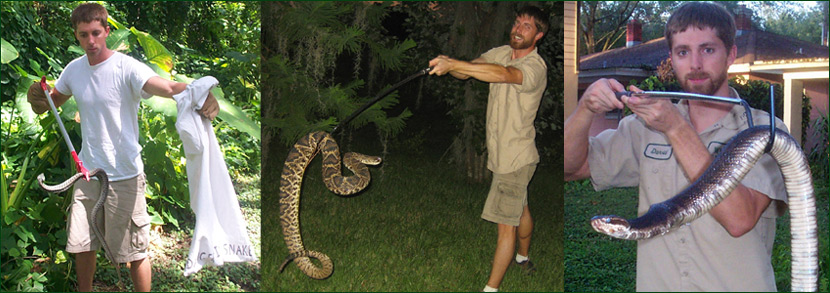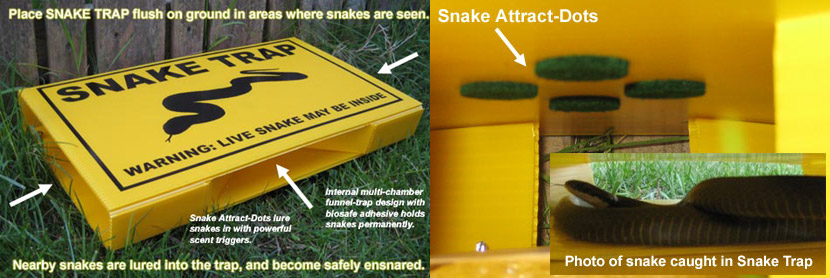Snake Tongs - Seen in the photo below on the left, this grabbing tool allows you to grab, hold, and move a snake safely, at a distance.
Snake Hook - Seen in the middle and right photo below, this tool allows you to scoop up larger snakes (no, you don't impale them on the hook!), and transport the snakes safely. I am holding
venomous Diamondback and Cottonmouth snakes in the below photos.
Snake Bag - I'm holding a simple bag in the photo on the left, but I have sturdier snake sacks, some attached to extending poles, so I can keep snakes at a distance. Be careful, pit vipers sense
heat, and can strike you right through a bag!
Thick Welder's Gloves - I grab most non-venomous snakes by hand, but I wear gloves, usually tight-fitting construction gloves, just to avoid the small teeth of Garter snakes and such.
Snake Boots & Pants - These are handy for walking around in the brush, if you don't want to be struck in the foot or ankle.
Snake Trap - Actually the safest way of all to catch a snake. Just be sure you check the trap every day, and relocate the snake after it's caught.

Safety Tools: Snake tongs for smaller snakes, snake hook for bulkier snakes, and a strike-proof snake sack to hold the snakes in. Thick welder's gloves can protect against Coral Snake bites, and the small
teeth of non-venomous snakes, but NOT against the large fangs of pit vipers like rattlesnakes, copperhead, or cottonmouth. Snake boots are helpful when walking through tall grass, as are snake pants (read more below
about these). Boots are sufficiently tall. Snakes don't jump up and bite you in the thigh or other areas. Read more about do snakes jump? You might also want to read
Why do snakes bite?
Snakes scare us, most of us, anyway. This fact is true for other animals as well. Horses, cattle, and other grazers will spook at the sight of a snake. This instinctual response is appropriate. In the wild, a grazer could meet an untimely end if the snake beneath its hooves is poisonous. Because we recognize a threat when we see a serpent, we feel the need to distance ourselves as soon as possible. When the snake is in our yard or home, we want to accomplish that feat even more quickly.
When trying to catch a snake, there are many ways to go about it, but the first thing that should be done is to identify the species. A non-venomous snake will be a lot less challenging to remove than a venomous snake. In fact, venomous snakes should only be removed with the help and guidance of a professional.

There are a number of ways to catch a snake without a resulting bodily injury. You can pick the snake up with you hand on its tail while supporting the front with a stick or branch, and you can also pick the snake up by grasping it firmly behind the head—as long as you know how to safely get that close to the snake! The down side to these methods is that you have to touch the snake. By touching the snake, you are placing yourself close enough to elevate the danger level. Many experts can pick a snake up without fear of being bitten; however, a novice snake handler should assume that touching the snake means it is very possible for a bite to occur. Special instruments such as snake tongs make handling snakes easier and safer.
The safest way to catch a snake is by avoiding contact with the snake completely. There are many methods of accomplishing this task, and most of these methods can be done with items around them home. A snake out in your yard can be coerced into a bin with a broom. Tip the bin upright after the snake enters and you have a confined snake ready to be transported. If this tactic sounds too easy, that’s because it usually is. You have to get the snake close enough to your bin and broom in order to scoot it inside. A snake will rarely remain stationary while it is being accosted with household items. Is it safe to handle a snake with bare hands?
Another hands-free method to catching a snake involves a long-handled net. Once the snake is located, the net is positioned in front of the serpent’s face. If the snake moves, the net moves. Ideally, the net is deep enough to look like an enticing hole. After the snake is adjusted to the sight of the net, you can startle the animal by gently touching its tail. Thinking the net is a safe hole to hide in, the snake will wiggle right in. Probably the best hands-off method of catching a snake is with a professionally endorsed snake trap. There are a number of these on the market, so select one that has good reviews from someone in the industry. A good snake trap should shield you from any contact with the reptile and should allow for you to remove it without an potential for injury.
Some animals, such as mongoose, eagles, or specially trained dogs and even pigs can catch snakes. Read about Snake Enemies - Animals that Catch Snakes here. Although, the odds of you owning and properly training one of these animals is slim.
None of these methods should be used when dealing with a poisonous snake. Every year, hundreds of people are injured because they try to catch a snake on their own. If you think the snake is venomous, or simply don’t know one way or the other, it is in your best interests to call a professional removal company.
You basically have four options for getting rid of your snake(s). First,
you can call a professional wildlife expert from my below directory.
This person can catch and remove the snake(s) and take other actions
necessary to solve the snake problem. Second, you can purchase a snake
trap if you wish to catch the snake yourself. Third, you can modify your
land and seal up your house to help keep snakes away and out of the
house. Fourth, you can try a snake repellent.
Option 1 - HIRE A PROFESSIONAL
We can solve your snake problem for you. Our nationwide group of snake specialists services 95% of the US population. Click here to find your local snake removal expert in your town. Below are just some of our more popular areas:Option 2 - BUY A SNAKE TRAP
If a snake is indoors, a trap will work. I do not recommend using a glue-based trap outdoors, because it can inhumanely catch other small critters. I have reviewed and field tested several snake trap designs, and the one featured below is the most durable and effective. It is the highest quality snake trap available on the market. Read more about Snake Trap.
For more information, go to my Snake Removal - How to Get Rid of Snakes home page. Snake repellent trousers - Snake-proof pants - Calling certain trousers or pants snake repellent is a bit of a misnomer. The pants generally do not contain any kind of chemical that will actively repel a snake, and even if the company boasted such a claim, they are usually false. What snake repellent safety pants or trousers do is cover enough of the body with strong enough material that a snake will be unlikely to penetrate in to the skin. Many people wear snake trousers and a tall pair of snake books when walking in new territory or when out in the wilderness. The danger is not that a snake is going to stalk you and catch you by surprise; the worry is that you are going to be the one to catch a snake by surprise. Most bites are accidental and happen when someone doesn’t see a snake in their path. The serpent’s first reaction to such an attack is to strike. It’s not that the snake is being mean or wants to eat your dead body; the animal just wants to get away from the heavy object stepping on it. Even when wearing snake trousers bites can happen. The upper body is just as prone to attacked as the lower, and many vipers can strike as high as a person’s face.